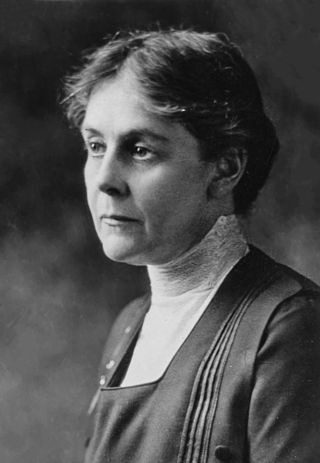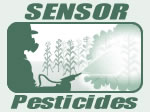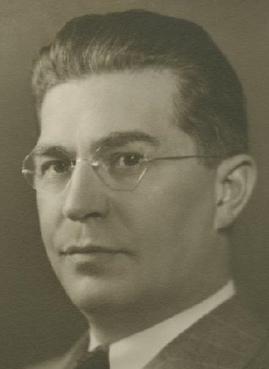Related Research Articles

Thomas Midgley Jr. was an American mechanical and chemical engineer. He played a major role in developing leaded gasoline and some of the first chlorofluorocarbons (CFCs), better known in the United States by the brand name Freon; both products were later banned from common use due to their harmful impact on human health and the environment. He was granted more than 100 patents over the course of his career.

Berylliosis, or chronic beryllium disease, is a chronic allergic-type lung response and chronic lung disease caused by exposure to beryllium and its compounds, a form of beryllium poisoning. It is distinct from acute beryllium poisoning, which became rare following occupational exposure limits established around 1950. Berylliosis is an occupational lung disease.
Pneumonoultramicroscopicsilicovolcanoconiosis is a 45-letter made-up word coined in 1935 by the then-president of the National Puzzlers' League, Everett M. Smith. It has sometimes been used as a synonym for the occupational disease known as silicosis, but it should not be as most silicosis is not related to mining of volcanic dusts. It is the longest word in the English language published in a popular dictionary, Oxford Dictionaries, which defines it as "an artificial long word said to mean a lung disease caused by inhaling very fine ash and sand dust".

The Occupational Safety and Health Act of 1970 is a US labor law governing the federal law of occupational health and safety in the private sector and federal government in the United States. It was enacted by Congress in 1970 and was signed by President Richard Nixon on December 29, 1970. Its main goal is to ensure that employers provide employees with an environment free from recognized hazards, such as exposure to toxic chemicals, excessive noise levels, mechanical dangers, heat or cold stress, or unsanitary conditions. The Act created the Occupational Safety and Health Administration (OSHA) and the National Institute for Occupational Safety and Health (NIOSH).

Silicosis is a form of occupational lung disease caused by inhalation of crystalline silica dust. It is marked by inflammation and scarring in the form of nodular lesions in the upper lobes of the lungs. It is a type of pneumoconiosis. Silicosis, particularly the acute form, is characterized by shortness of breath, cough, fever, and cyanosis. It may often be misdiagnosed as pulmonary edema, pneumonia, or tuberculosis. Using workplace controls, silicosis is almost always a preventable disease.

Alice Hamilton was an American physician, research scientist, and author. She was a leading expert in the field of occupational health, laid the foundation for health and safety protections, and a pioneer in the field of industrial toxicology.

Black lung disease (BLD), also known as coal-mine dust lung disease, or simply black lung, is an occupational type of pneumoconiosis caused by long-term inhalation and deposition of coal dust in the lungs and the consequent lung tissue's reaction to its presence. It is common in coal miners and others who work with coal. It is similar to both silicosis from inhaling silica dust and asbestosis from inhaling asbestos dust. Inhaled coal dust progressively builds up in the lungs and leads to inflammation, fibrosis, and in worse cases, necrosis.

Herbert Leroy Needleman researched the neurodevelopmental damage caused by lead poisoning. He was a pediatrician, child psychiatrist, researcher and professor at the University of Pittsburgh, an elected member of the Institute of Medicine, and the founder of the Alliance to End Childhood Lead Poisoning. Dr. Needleman played a key role in securing some of the most significant environmental health protections achieved during the 20th century, which resulted in a fivefold reduction in the prevalence of lead poisoning among children in the United States by the early 1990s. Despite engendering strong resistance from lead-related industries, which made him the target of frequent attacks, Needleman persisted in campaigning to educate stakeholders, including parents and government panels, about the dangers of lead poisoning. Needleman has been credited with having played a key role in triggering environmental safety measures that have reduced average blood lead levels by an estimated 78 percent between 1976 and 1991. He died in Pittsburgh in 2017.

Diana M. Zuckerman is an American health policy analyst who focuses on the implications of policies for public health and patients' health. She specializes in national health policy, particularly in women's health and the safety and effectiveness of medical products. She is the President of the National Center for Health Research and the Cancer Prevention and Treatment Fund.
Rick Nevin is an economic consultant who acts as an adviser to the National Center for Healthy Housing and has worked on the Federal Strategy to eliminate childhood lead poisoning. Amongst other research, he has published papers in the journal Environmental Research claiming to demonstrate a link between environmental lead exposure and violent crime in the United States and in nine countries worldwide. This research has been publicized in the press by a Washington Post article in July 2007, by Mother Jones in 2013, and elsewhere, including the UK's Independent in October 2007 and Guardian in 2013. Nevin's work on lead pollution has also featured in numerous books about public health, social sciences and social justice, criminology, environmentalism and sustainability, and air pollution.

Sentinel Event Notification System for Occupational Risks (SENSOR)-Pesticides is a U.S. state-based surveillance program that monitors pesticide-related illness and injury. It is administered by the National Institute for Occupational Safety and Health (NIOSH), twelve state health agencies participate. NIOSH provides technical support to all participating states. It also provides funding to some states, in conjunction with the US Environmental Protection Agency.
The Baby Tooth Survey was initiated by the Greater St. Louis Citizens' Committee for Nuclear Information in conjunction with Saint Louis University and the Washington University School of Dental Medicine as a means of determining the effects of nuclear fallout in the human anatomy by examining the levels of radioactive material absorbed into the deciduous teeth of children.

Yandell Henderson was an American physiologist. The New York Times called him an "expert on gases" and "an authority on the physiology of respiration and circulation and on pharmacology and toxicology of gases". He was also noted for new methods in resuscitation. Henderson was a director of the Yale Laboratory of Applied Physiology at Yale University, a member of the National Academy of Sciences, chairman of the section of physiology and pathology of the American Medical Association. He was also a member of the American Philosophical Society. A collection of his papers are held at the National Library of Medicine in Bethesda, Maryland.
Industrial Bio-Test Laboratories was an American industrial product safety testing laboratory. IBT conducted significant quantities of research for pharmaceutical companies, chemical manufacturers and other industrial clients; at its height during the 1950s, 1960s, and 1970s, IBT operated the largest facility of its kind and performed more than one-third of all toxicology testing in the United States. IBT was later confirmed of engaging in extensive scientific misconduct and fraud, which resulted in the indictment of its president and several top executives in 1981 and convictions in 1983. The revelations of misconduct by IBT Labs led to reforms in the regulation of pesticides in the United States and Canada.

Robert Arthur Kehoe was an American toxicologist and a dominant figure in occupational health. Working on behalf of the lead industry, Kehoe was the most powerful medically-trained proponent for the use of tetraethyllead as an additive in gasoline.
Joseph Charles Aub (1890-1973) was an American endocrinologist and professor then chair of medicine at Harvard University. He graduated from Harvard College and Harvard Medical School.
Gerald Markowitz is an American historian, currently a Distinguished Professor at John Jay College of Criminal Justice, City University of New York (CUNY) and also a published author.
The Lead Industries Association (LIA) was a trade organization that in 1925 made it possible for Tetraethyllead to be an additive of commercial gasoline and later incorporated in 1928 to promote the interests of the lead industry. The National Lead Institute was a predecessor of the Lead Industries Association The association lobbied to lift bans on, and promote the use of, lead pipes. The association also promoted lead-based paints, which became the subject of a poisoning lawsuit filed against paint manufacturers. In 1958, the LIA and the American Zinc Institute founded an organization with a similar mission that outlasted the LIA, the International Lead Zinc Research Organization (ILZRO). In 2002, the Lead Industries Association of Sparta, NJ, went bankrupt and defunct citing that they were unable to get insurance to cover the litigation against them.

The Division of Industrial Hygiene was a division of the U.S. Public Health Service (PHS) with responsibility for occupational safety and health programs. It existed from 1914 until 1971, when it became the National Institute for Occupational Safety and Health (NIOSH). It had several names during its existence, most notably the Office of Industrial Hygiene and Sanitation in its earlier years and the Division of Occupational Health during its later years.
The Royal Commission on the Health and Safety of Workers in Mines, informally known as the Ham Commission, was a 1974 Canadian royal commission founded to investigate and report on the safety of underground mines.
References
- 1 2 "Biographical Profiles: David Rosner". Columbia University Mailman School of Public Health. Columbia University. Retrieved September 20, 2018.
- ↑ Klibanoff, Eleanor (March 23, 2016). "Lead Paint Was Banned 40 Years Ago; Why Is It Still A Problem In PA?". NPR All Things Considered. Pittsburgh Community Broadcasting Corporation. Retrieved March 11, 2021.
- ↑ Lord, Peter B. (January 19, 2006). "Lawyer, historian spar over lead paint". The Providence Journal. The Providence Journal Co. Archived from the original on July 9, 2006. Retrieved March 11, 2021.
- ↑ "A Surprise Environmental Health Victory at the U.S. Supreme Court". Columbia University Mailman School of Public Health. Columbia University. October 22, 2018. Retrieved March 11, 2021.
As the case proceeded, Rosner and Markowitz were each on the stand for the better part of three days.
- ↑ Jasen, Georgette (March 16, 2014). "Exposing the Hazards of Lead Poisoning". Columbia News. Columbia University. Retrieved March 11, 2021.
A California judge has called David Rosner "the people's historian."
- ↑ Sze, Julie (Fall 2016). "Lead Wars: The Politics of Science and the Fate of America's Children by Gerald Markowitz, David Rosner (review)". Bulletin of the History of Medicine. 90 (3): 570–571. doi:10.1353/bhm.2016.0094. S2CID 78905544 . Retrieved March 11, 2021.
- ↑ "About Toxic Docs". Toxic Docs. New York: Columbia University and City University of New York. 2018. Retrieved March 11, 2021.
- ↑ Whitehouse, Sheldon (2018). "ToxicDocs: using the US legal system to confront industries' systematic counterattacks against public health". Journal of Public Health Policy. 39 (1): 22–23. doi: 10.1057/s41271-017-0105-9 . PMID 29348451.
- ↑ "Pulling Back the Curtain on Industrial Toxins". Columbia University Irving Medical Center. Columbia University. February 7, 2018. Retrieved March 12, 2021.
"A single document by itself doesn't tell the whole story," says Chowkwanyun. "ToxicDocs connects the dots. This larger dataset paints a much bigger picture."
- ↑ Shine, Gautam (2017). "Document analysis and classification for the ToxicDocs collection". GitHub. Retrieved March 15, 2021.
A common narrative is that a toxic substance was known to be harmful to the chemical industry well before it's exposed as such and gets banned by government agencies.
- ↑ Root, Tik (January 10, 2018). "In ToxicDocs.org, a Treasure Trove of Industry Secrets". Undark Magazine . Knight Science Journalism . Retrieved April 9, 2021.
with Chowkwanyun, they started by creating a website and uploading the maligned chapters of "Deceit and Denial," with each footnote linked to the original supporting documents in their entirety. ... Since then, Chowkwanyun has expanded that early effort into what is now called ToxicDocs.org
- ↑ Fox, Daniel M. (2013). "A Once Charitable Enterprise (book review)". Nonprofit Policy Forum. 4 (1). doi: 10.1515/npf-2013-0009 . S2CID 163706820 . Retrieved March 11, 2021.
- ↑ Galishoff, Stuart (1996). "Hives of Sickness: Public Health and Epidemics in New York City (review)". Bulletin of the History of Medicine. 70 (3): 552. doi:10.1353/bhm.1996.0111. S2CID 58776268 . Retrieved March 11, 2021.
- ↑ Pernick, Martin S. (December 1, 1980). "Health Care in America: Essays in Social History (review)". Journal of American History. 67 (3). doi:10.2307/1889935. JSTOR 1889935 . Retrieved March 11, 2021.
- ↑ Sokas, Rosemary K. (April 9, 1992). "Deadly Dust (review)". The New England Journal of Medicine. 326: 1031–1032. doi:10.1056/NEJM199204093261521 . Retrieved March 11, 2021.
- ↑ Proctor, PhD, Robert N. (April 1, 1992). "Deadly Dust (review)". Journal of the American Medical Association. 267 (33): 1842. doi:10.1001/jama.1992.03480130162047 . Retrieved March 11, 2021.
- ↑ Berkowitz, Edward D (July 1, 1988). "Dying for Work: Workers Safety and Health in Twentieth Century America. Edited by David Rosner and Gerald Markowitz (review)". Journal of Social History. 21 (4): 803–805. doi:10.1353/jsh/21.4.803 . Retrieved March 15, 2021.
- ↑ Cumbler, John T. (December 1, 1988). "Slaves of the Depression (book review)". Journal of American History. 75 (3): 1005. doi:10.2307/1901694. JSTOR 1901694 . Retrieved March 11, 2021.
- ↑ Gorman, Hugh S. (January 2004). "Deceit and Denial: The Deadly Politics of Industrial Pollution (review)". Technology and Culture. 45 (1): 219–221. doi:10.1353/tech.2004.0016. S2CID 110731069 . Retrieved March 11, 2021.
- ↑ "Journal of Public Health Policy". Palgrave MacMillan. Retrieved 12 March 2021.
- ↑ "Editorial Board". The Journal of Scientific Practice and Integrity. Retrieved 12 March 2021.
- ↑ "Environmental Justice". Mary Ann Liebert, Inc., publishers. Retrieved 12 March 2021.
- ↑ "Rochester Studies in Medical History". Boydell & Brewer. Retrieved 12 March 2021.
- ↑ "Emilie FitzMaurice, Zachary Rosner". The New York Times. May 18, 2014. Retrieved 12 March 2021.
- ↑ "David Rosner - Biography". Columbia University Irving Medical Center. Columbia. 2019. Retrieved March 11, 2021.
- ↑ "David Rosner". The Center for Science and Society. Columbia University. 2018. Retrieved March 11, 2021.